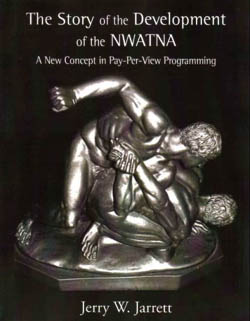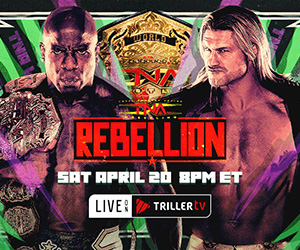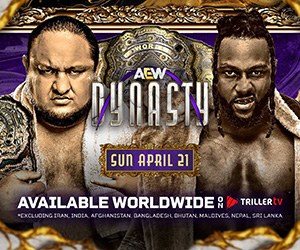Have you ever imagined what it would be like to read the diary of a major wrestling promoter? If so, The Story of the Development of the NWATNA: A New Concept in Pay-Per-View Programming allows your imagination to become a reality.
Published in 2004, the journal is a step inside the shoes of TNA co-founder, Jerry Jarrett, during the formation of TNA in 2002. Essentially, readers are given a day-by-day synopsis of Jarrett’s personal life pertaining to the wrestling venture.

With the recent release of The History of TNA: Year 1 DVD, Jarrett’s journal helps to fill in the gaps as well as expound on several key points during the company’s inaugural year. Jarrett’s frustrations with current TNA management members, such as Dixie Carter (President) and Chris Sobol (Vice President of Operations), are also documented throughout. If you are a fan of a lot of graphics, you may find it difficult to digest the 176 pages of pure text. However, the entries are spliced with e-mails sent to TNA and Panda Energy staff members as well as the complete Kayfabe Memories interview with Jarrett conducted by Tim Dills to keep your attention without deviating from the core dialogue.
In a candid interview with SLAM! Wrestling, Jarrett explained that he began writing a journal in order to have a daily chronicle of his life for future generations after discussing his late mother, Christine Jarrett, with his children.
“A publisher out of Canada contacted me about writing a book about the process of beginning TNA,” continued Jarrett. “I began reading my journal so that I could refresh my memory. My first step was to delete everything relating to my construction/development business simply because I, in effect, had two totally unrelated lives going on at the same time. It was confusing even to me to try to follow the wrestling related events. After I had the year 2002 edited to only the wrestling-related material, I decided the only way to present the truth was to print the journal as it was. I have quite an extensive library and 99.9% of the library is nonfiction. I suppose because I lived a life that involved fiction on a daily basis, I have an aversion to fiction in my reading. All the book publishers I had contact with wanted a heavily-edited version and wanted to take creative liberties with the facts. In my mind, this would turn the book into fiction. I decided to publish the journal as it was.”
The first entry, 12/31/01 — Hendersonville, is a self-examination of Jarrett’s personal life and career in both wrestling and construction. The subsequent entries focus on the business plan and conceptual process for what would become known as NWA-TNA, and later TNA Wrestling.
From the onset, Jarrett faced concerns about the success of TNA.
“My wife, Deborah, suggested that I just give [his son] Jeff a bundle of money instead of getting back into the wrestling business,” recalled Jarrett. “My son, Jason, predicted failure from the beginning. My daughter, Jennifer, and my friends had an inflated opinion of my ability and felt like the company would thrive. I explained to my wife that win or lose, I had to try to help Jeff.”
The financial aspects are greatly detailed in this book. As a result, I now have a better understanding as to why it is so difficult to start and maintain a wrestling company from scratch. For example, the situation with TNA’s original financial backer, the HealthSouth Corporation, reneging on the deal as well as the Jarretts scrambling to find a new means of monetary support is described thoroughly throughout the journal.
Jarrett’s initial suspicions of Jay Hassman, TNA’s former pay-per-view consultant — whose services would later be terminated after it was revealed he was falsifying information as well as failing to disclose his affiliation with Team Services (a company which marketed WWE’s pay-per-view programming at the time) — are also documented.
“Things often look very different from a distance,” elaborated Jarrett during the interview. “While I blamed Hassman for our early demise, in retrospect, his actions only speeded up our dire need for financial help. Hassman’s negative efforts were not responsible for our poor showing on pay-per-view. Sure, they would have been better if he had advertised in areas that could buy our product. Sure, we might have cut expenses drastically had we known how bad the situation was as far as pay-per-view buys, but we would have still run out of money because our plan was flawed from the beginning. Our assumption was that word of mouth and the Internet buzz would get enough fans to kickstart our audience and like a good soap opera, we would have the fans return each week and pick up new fans, and the audience would grow and be profitable. We tried to reinvent the wheel of professional wrestling and failed.
“The wrestling business is not different today than it was in 1960,” continued Jarrett. “A promotion needs a television show, which is an hour or two infomercial, to drive fans to the event. Pay-per-view and live events require the same promotion on television. The list is probably quite long as to the why of our failure, but Hassman is only a footnote.”
According to the 07/25/02 — Hendersonville journal entry, a telephone call took place between Jeff Jarrett, Vince Russo, Jerry Jarrett and Vince McMahon about Hassman’s actions at the request of McMahon.
“When I had the conversation with Vince at the time of the incidence, I felt certain that Vince was responsible for Hassman,” explained Jarrett. “Hindsight is 20/20 after you have had time to gather more information. I later discovered that WWE contracted with a company to market their pay-per-view events. Hassman went to work for that company. The $64,000 question is did Hassman use his status with us to gain his job with the WWE contractor? Hassman is not a honorable man and his later actions proved this as fact. People who take advantage of others for their personal gain usually fail in the long run.”
The journal also describes how a variety of big name wrestlers were contacted about joining the company in 2002 such as Mick Foley. “Mick and I had limited discussions concerning his role at TNA,” added Jarrett. “At the time, Mick did not want to wrestle a full-time schedule. I suggested he come on board as either a color announcer for special matches, or a company official like the TNA President. We then talked about how he could get involved in a big match on special occasions. Our conversations were not really detailed because Mick said he would have to wait until his non-compete period had expired.”
Speaking of The New York Times best-selling author, the format of Jarrett’s journal is somewhat similar to Foley’s The Hardcore Diaries, which was published earlier this year. In the chapter entitled “Good-bye, Vince” Foley describes nearly signing with TNA by writing:
I had been contacted by them sporadically over the years, but had not really been interested, until some recent conversations with company cofounder Jeff Jarrett about the new direction of the group sparked an interest … So I talked a few times with Jeff Jarrett, and agreed to meet for a double-secret breakfast at the Long Island Hilton in August 2005. I’d known Jeff since 1988, when I got my first full-time break, in his father’s company, and despite the fact that I didn’t really enjoy my time in the Memphis territory, I had always liked Jeff and considered him to be a quality guy. It was amazing to see how closely Jeff’s vision of my future role in TNA compared to mine: an initial match with Abyss, a talented big man who has taken a page or two out of the old Mick Foley playbook. A couple of big matches with [Samoa] Joe, including an angle that would have served as a new textbook example of how to get a guy over. And then a title shot with Jarrett.
A bewildered Jerry Jarrett shared his response to the above passage by saying, “I’m really surprised that Mick wrote that he did not enjoy his stay in Memphis. So often, wrestlers will view their history very much different than it was at the time. Mick admits that I gave him his first break in the business. Mick, at the time, was a limited and inexperienced wrestler in Dallas. He had a terrible body and no interview skills. This is not a knock because only a handful of new wrestlers ever had natural interview ability. In my experience, only Jerry Lawler, Dusty Rhodes and ‘Handsome’ Jimmy Valiant had natural interview talent.
“The actual events were that Mick was working a very limited number of shots for me in Dallas as one of the enhancement talents,” continued Jarrett. “No one, including myself, really noticed Mick as a talent. However, Mick had a desire to learn the behind the scenes aspect of the business, so he would come to the studio each week when I came to oversee the editing of the shows. I got to know Mick and discovered that he was exceptionally intelligent. I encouraged him to learn all he could about the television end of the business. We were coming to Dallas on a tour bus and then returning to Memphis with a few of the Dallas wrestlers, who would then work the territory and return to Dallas the next Friday night. Mick kept asking if he could come to Memphis with us. He accurately stated that he could not improve without experience. I finally had an opening that I thought Mick could fill and he began returning to Memphis with us. I don’t know how he could not have wonderful feelings about the Memphis promotion considering that he would not have had the financial success he has enjoyed without that experience.”
From the beginning, TNA’s critics accused the company of catering directly to the Internet wrestling community. Jarrett explained his views about the Internet audience as well as the impact of the wrestling media by saying, “Again, hindsight is always 20/20, so long after it was too late, I realized that the e-mails and websites represented so small a percentage of the television audience as to be insignificant. We let the tail wag the dog and the cost in dollars was significant. The Internet crew loved the X Division. The general public did not buy it on a large scale. I’ve said before that Vince McMahon is head and shoulders above the rest in his feeling for what the public will pay for. Vince likes big men as his talent, and the reason is that big men sell tickets. The WWE has its form of X Division, but instead of featuring them, they are an exciting enhancement to his cards. I only regret that I paid too much attention to the wrestling websites and allowed them to influence me and the way I promoted wrestling. During the old territory days, I discovered that the wrestling media will write what they want and will not let facts stand in the way. I quit reading the newsletters and quit talking to them. Then when we started TNA, I began reading the message boards all morning the day after our events to determine if what we were doing was good or bad. It would be easy at this point to blame Bob Ryder or Jeremy Borash and say that they came from the Internet world and were a terrible influence on me. It would also be easy to blame the fact that 90 percent of our company came from the failed WCW world, and they were accustomed to the influence of the wrestling message boards. The truth is, I was the only person in our company with experience in running a wrestling promotion, and I was not faithful to the tenets of my former success.
“As to how I think the wrestling media impacts the wresting business in general,” continued Jarrett. “I know it does not influence WWE, and I do not know if it still influences TNA. I would venture a guess that it has great impact on the small independent promoters. Since getting completely out of the business, I realize how really silly I was to allow the wrestling media to influence me at all. While in the business, you believe that the entire world is somehow involved in the wrestling business as either a fan on some level or inside the business. Once out of the business, you realize that only a very small percentage of the population watches wrestling on television. Then only a very small percentage of these people buy a ticket to a live event or pay for a pay-per-view. Of this group that buy tickets, an even smaller percentage read the Internet wrestling message boards or read a wrestling newsletter. Whatever influence the wrestling media has, it is very much overrated. Now with that said, in the world of wrestling and its fans, the media is very important to that group that follows the Internet sites and newsletters. Therefore the quality and integrity of the stories is important.”
During the conversation with SLAM! Wrestling, Jarrett also discussed various reports and speculations about his estranged relationship with his son, Jeff, specifically comments that have appeared over the past few years in Dave Meltzer’s Wrestling Observer newsletter by stating, “Years ago, I would have immediately started searching the Internet to find out what was written. Today I will not simply because it does not matter. I would venture to bet that a person could go to any mall or busy street corner in America and one, at the most, out of 100 would know who Meltzer was. If you could find 10 out of 1,000 people who knew Meltzer, not a single one of those would know anything about some negative comment he made about me. The fact that Meltzer expressed any opinion at all about something that he knows nothing about, the fact that Meltzer failed to even attempt to get a comment from the subject of his comments, says more about the integrity of his newsletter than I could ever say.”
The 65-year-old grandfather currently resides in Franklin, Tennessee with his wife where he is content to no longer be a part of the wrestling business and instead focus on spending time with his family. When the notion of writing an autobiography was brought up, Jarrett responded, “No, I have no plans to write an autobiography. The only part of my life that is perhaps of interest to the public is the wrestling history, and I do not think that defines who I am or even the most important part of my life. It is only the most public part of my life. It might surprise you to know that the bulk of my good fortune as far as wealth has come from the construction/development company. I made enough money in the territory days to buy property. I sold some of the property and kept some to later develop. I will always be thankful that the wrestling business afforded me the seed money to build a comfortable life.
While Jarrett’s tenure with TNA and career in wrestling both appear to be over, The Story of the Development of the NWATNA: A New Concept in Pay-Per-View Programming is a candid look back at the formation of TNA that I recommend to wrestling fans who enjoy taking a peek inside when the curtain is pulled back — or in this case pulled down.
THE BOOK COVER
“When we moved from Channel 13 to Channel 5 in Memphis, the station asked if I would produce a new opening for our show,” recalled Jerry Jarrett. “My wife had given me this famous statue, which depicted the wrestlers in the classic style. Most wrestling shows had highlights of action with their top stars. I wanted an opening that was not time sensitive and would not have to be changed as the talent changed. I wanted to have an opening that gave us a consistent recognition. I placed the statue on a revolving platform, added music and graphics and had our opening. Later, we used the statue in the TNA opening.”
THE TNA NAME
“This is one of the battles with Vince Russo that I lost,” explained Jerry Jarrett. “Russo convinced Jeff that new and edgy was what I considered vulgar and lowbrow. The letters TNA, when said, sounds like ‘T & A’, which is ‘Tits and Ass.’ There is no way to know how many people were turned off of TNA because of the name. The wrestling world has always wondered what happened to the WCW fans after they went out of business. My belief is that they simply quit watching wrestling because the alternative was the ‘edgy era’ of WWE and TNA’s name alone signified more ‘WWE edgy’. … As it turned out, the initials TNA came first, and Total Nonstop Action was crafted to explain the initials.”
RELATED LINK



